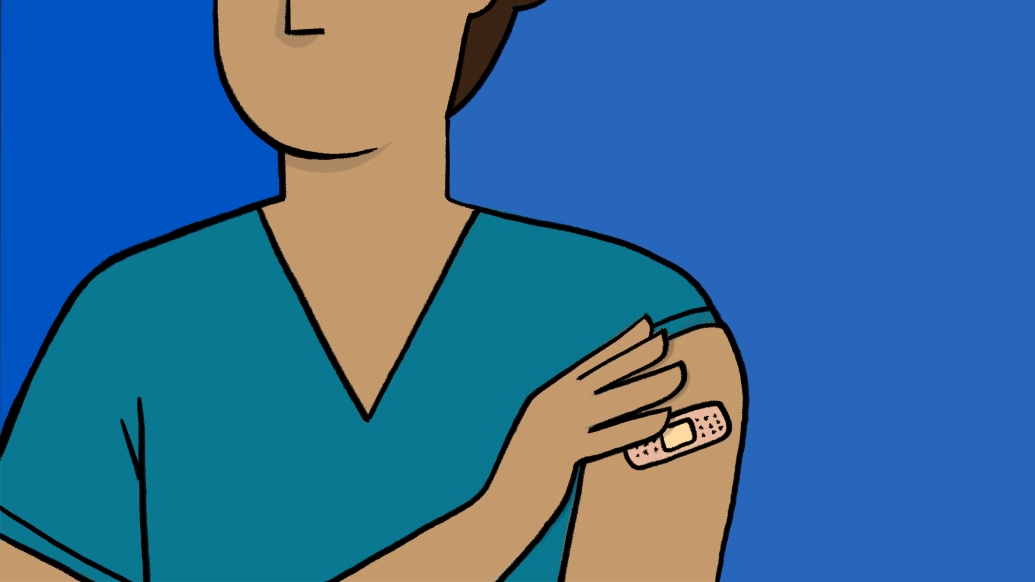VA hospitals now outpace non-federal hospitals in mandating influenza vaccination or waivers and masks for all staff, after lagging for years
10:12 AM
Author |

In just a few months, hospitals and health systems nationwide will start working to vaccinate as many staff as possible against the flu.
And a study suggests that more of those hospitals than ever before will require employees to get vaccinated, or seek an exemption.
That means more patients could avoid catching the flu while receiving health care – a key goal for improving patient safety.
In all, the study shows that 96% of the hospitals that serve America’s Veterans, and 74% of hospitals serving the general public, now require staff to get vaccinated against influenza or seek an exemption.
SEE ALSO: Majority of older adults say health care workers should have to get COVID-19 vaccine
Another 23% of non-Veterans Administration hospitals strongly encourage but don’t require flu vaccination.
Whether or not they have a mandate, 81% of non-VA hospitals require unvaccinated workers to wear a mask around patients during flu season.
Published in JAMA Network Open, the study was done by a team from the University of Michigan and VA Ann Arbor Healthcare System that has surveyed hospitals on this topic since 2013.
Their latest survey reveals the massive impact of a 2020 Veterans Health Administration directive to require flu vaccination or waivers for the first time.
In 2013, only 1% of VA hospitals had such a mandate; the percentage rose slightly to 4% by 2017.
Meanwhile, flu vaccination or a waiver was required by 43% of non-VA hospitals in 2013, rising to nearly 70% in 2017.
“Our findings show the impact of one of the largest health care systems in the United States taking a stand and putting a policy in place that is based in a bedrock ethical principle of medicine: Do no harm,” said Todd Greene, Ph.D., M.P.H., lead author of the study and a patient safety researcher at VAAAHS and Michigan Medicine, U-M’s academic medical center.
“In addition to the VA national directive, it is interesting to see how the COVID-19 era influenced flu vaccine requirements at non-VA hospitals.”
He and his colleagues, including senior author Sanjay Saint, M.D., M.P.H., sent surveys to a national sample of hospitals starting in April 2021, and received replies from 405 non-VA hospitals providing general medical and surgical care, and 66 VA hospitals.
Our findings show the impact of one of the largest health care systems in the United States taking a stand and putting a policy in place that is based in a bedrock ethical principle of medicine: Do no harm."
-Todd Greene, Ph.D., M.P.H.
In addition to asking about mandates and mask requirements, they asked hospitals that have a mandate to share what types of exemptions are permitted.
Virtually all VA and non-VA hospitals allowed for medical exemptions, while there was a difference for religious exemptions, with 82% of non-VA and 95% of VA hospitals allowing these.
A very small minority of hospitals (6% of non-VA hospitals and 2% of VA hospitals) allowed waivers to be granted without a specific reason.
At the time of the survey, which began at the end of the first flu season after the VHA directive, only 33% of VA hospitals with a mandate said they had penalties in place for staff who did not getting vaccinated or pursue a waiver.
By comparison, 74% of the non-VA hospitals with mandates had such penalties in place.
SEE ALSO: Vaccines: A few minutes now could spare you misery later
Greene notes that surveys of American health care workers show that flu vaccination percentages have dropped over time, from 91% during the 2019-2020 season, to 81% by the 2022-2023 season.
These percentages include health care workers who work in any setting, not just hospitals and health systems such as those surveyed for the new study.
“There will always be vaccine hesitancy and concerns about bodily autonomy among health care workers, and seasonal flu vaccine effectiveness is variable,” Greene said.
“But for people working in the care environment, the benefits of getting vaccinated will generally outweigh any potential risks.”
In addition to Greene and Saint, the study’s authors are Kathleen Linder M.D. and Karen E. Fowler MPH. Greene, Saint and Fowler are members of the U-M/VA Patient Safety Enhancement Program, and Greene and Saint are members of the U-M Institute for Healthcare Policy and Innovation.
The study was funded by the VHA National Center for Patient Safety.
Paper cited: “Influenza vaccination requirements for health care personnel in US hospitals,” JAMA Network Open. DOI:10.1001/jamanetworkopen.2024.16861
Sign up for Health Lab newsletters today. Get medical tips from top experts and learn about new scientific discoveries every week by subscribing to Health Lab’s two newsletters, Health & Wellness and Research & Innovation.
Sign up for the Health Lab Podcast: Add us on Spotify, Apple Podcasts or wherever you get you listen to your favorite shows.

Explore a variety of health care news & stories by visiting the Health Lab home page for more articles.

Department of Communication at Michigan Medicine
Want top health & research news weekly? Sign up for Health Lab’s newsletters today!




